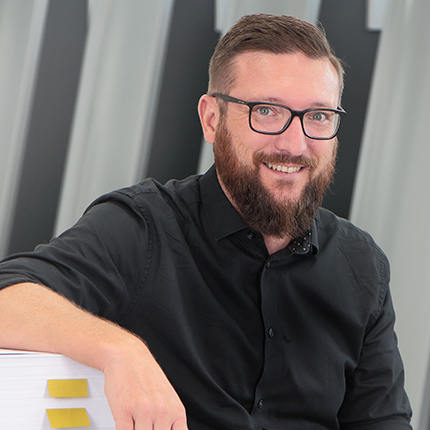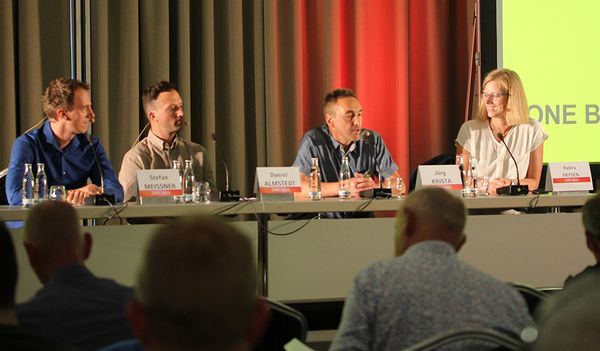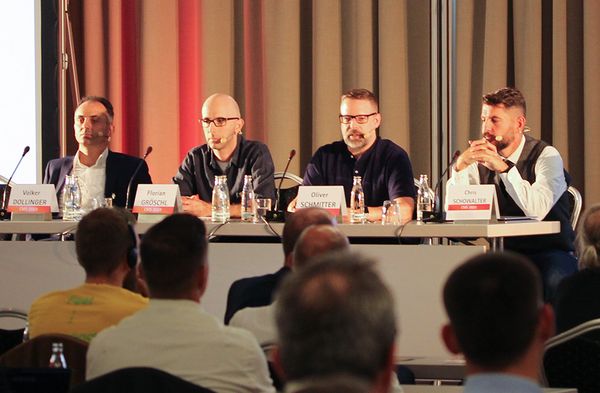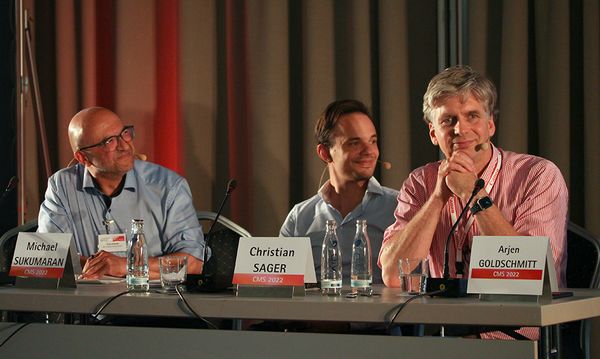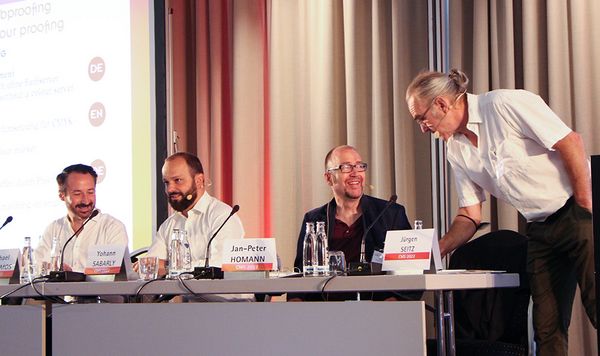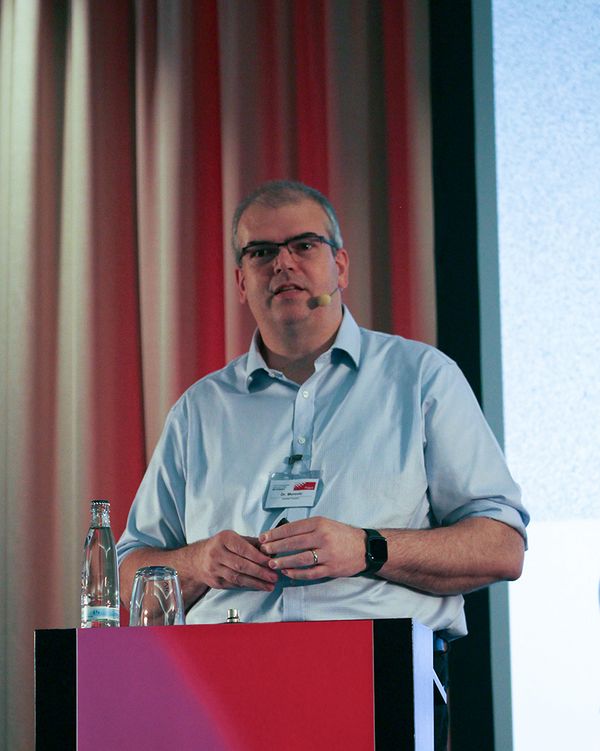Topic of your interest
The Colour management industry meeting takes off
Medienvorstufe Press releases 07/20/2022
In seven sessions, exclusively users reported on the trend topics of customer expectations, modern workflows, multi-colour printing, proofing and digital textile printing.
Session 1
Managing customer expectations: “Educated customers make educated decisions“ (Moderation: Rabea Paysen, X-Rite)
To kick off the event, Jörg Krista (Alfred Kärcher) presented the implementation of the brand colour "Kärcher Yellow" – including all the challenges and stumbling blocks. On the way to "One Brand, one Colour" it was necessary to characterise the different substrates and printing processes and to establish an own Kärcher standard.
The presentation by Daniel Almstedt (Mods Graphic Studio) was covering an emotional discussion. He made it clear: concrete colour development is the result of preceding emotional wishes and design intentions of the creatives.
Afterwards, Stefan Meissner (Vistaprint) reported on the great importance of a flexible data model for the mapping of complicated job bags. He showed the development of JDF (Job Definition Format) from a job pocket description to an interface technology. He made it clear that it is not the JDF but the ICS compatibility that is important, i.e. the concrete subset of necessary details. He summarised the lecture according to Wittgenstein: The limits of your data model are the limits of your automation.
Session 2
Modern colour workflows (Moderation: Chris Schowalter, EFI – Electronics for Imaging)
Oliver Schmitter (Christinger) opened the session with a story about the development of the print service provider and the challenges of preparing data uniformly. A central data preparation is hindered in particular by the fact that every printing press is supplied with its own RIP – and this naturally provides the best colour management. He explained how certification by the ProcessStandard Digital (PSD) helped him to implement a uniform workflow.
Florian Gröschl (Gugler Druck) then showed how much the switch from FOGRA47 to FOGRA52 helped them to reduce customer complaints and simply print well".
Volker Dollinger (Aumüller Druck) concluded the session by explaining the benefits of adopting SCTV as a modern method of tonal calibration. He used this to establish an own printing condition (FOGRA51, but with FM screening). The conversion, i.e. data conversion, of the FOGRA51 customer data was done with a DeviceLink profile. In the end, both the customer and the printer were delighted.
Session 3
Process-agnostic mulitcolor printing (ECG) (Moderation: Dietmar Fuchs, ColorLogic)
Gehard Bley (Imagic Bildverarbeitung) and Eugen Stamm (Stoba Druck) kicked off the third session. They reported on the implementation of a chromatic calendar project by photographer Michael Lange. For this purpose, an own CMYKOGV printing condition was established and characterized. Both of them with vivid samples on-site demonstrated the efficient implementation using colour servers.
Andreas Praß (All4Labels Global Packaging Group) then reported the steps taken so far towards the goal of a uniform colour standard: across all locations and printing processes. This is particularly complicated by the fact that each location has different requirements for software, hardware and also brainware. The PSD, which may be applied to flexo printing as well across all processes, serves as the roadmap.
Andreas Kraushaar (Fogra Fogra Forschungsinstitut für Medientechnologien) reported on an unsuccessful attempt to objectify the smoothness of ECG separations. The idea was to develop a previously conceived idea using of colour-psychologically evaluated practical prints. Unfortunately, no correlation was found. Therefore, a list of concrete recommendations and guidelines for modern multicolour printing was presented instead.
Session 4
How single pass inkjet disrupts commercial, packaging and industrial markets (Moderation: Arjen Goldschmidt, Canon)
The last session of the day was about the disruptive changes in single-pass inkjet printing. Christian Sager (Kyburz) started the session with his search for the perfect press – including a 100% inline solution for mailing production. He spoke plainly and surprised some suppliers – especially because the printing company is responsible for the overall integration.
Michael Sukumaran (MKT) showed the challenges and the required quality standards in industrial printing of edge bands – an area that is increasingly being conquered by high-speed inkjet printing. Here, quality control is still mainly done visually and under the D65 sample light.
The fourth session ended with Roye Dodds (Egger Group). He reported on the currently most advanced stage of print evaluation: measuring in the image. Here the print motif is measured – without control strips – during the digital printing process, corrected in the RIP and used for immediate control of the production run.
The fitting wrap-up to the first day was the keynote address by Dimitris Mylonas (Northeastern University UK) during the social evening. He spanned from Aristotle and the colours of the rainbow to modern colour naming research. Current research in several countries interestingly shows that women, in contrast to men, use the word cyan less or almost not at all. He used other impressive examples to show how deeply the use of colour is connected to the different languages.
2. day of the symposium
Session 5
Jan-Peter Homann (homann colourmanagement) began his presentation by listing the weaknesses of current design programs in dealing with multicolour printing and presenting a more practical proposal: This is a new colour profile that, starting from FOGRA39, increases the colour gamut, especially in orange, green and blue-violet. He is looking for interested parties to test this profile in practice. With simple, established possibilities, additional colour ranges can be used in modern multi-colour printing systems.
Yohann Sabarly (SGS & Co) reported on the multicolour implementation of important brand owners from the colour reference to the proof to the press proof. He showed the different degrees of difficulty of the customer data, which require adapted proof strategies in each case.
Michael Guggemos (Nägele Digital Repro), who serves flexo printers with printing plates (clichés) concluded the session. He reported on the unequal instrumental equipment of prepress and printing plants. In conclusion, he showed possible solutions for producing colour-accurate proofs for challenging substrates such as tea bag paper.
Session 6
Colour communication for digital textile printing (Moderation: Gerard Buch, Inédit)
Joe Tschudi (Tschudi Software Technology) reported on the differences between graphic production and conventional and digital text printing. He focused on referencing, i.e. the specification of colour by any digital and physical means – using D65. Andreas Kraushaar showed that further material characterisation is necessary for the textile colour representation going from 2D to 3D.
Claas Bickeböller (Konica Minolta Sensing) reported on modern methods of gamut mapping with a focus on the grey axis and papers with a high proportion of optical brighteners. These results can also be read in Fogra Extra 42.
The sixth session was concluded by Georg Lutz (Junkers & Müllers) with a plea for a Media Setting Exchange Format. Such a central recording of essential parameters of print control (PrintMode) would save the manufacturers of materials as well as the users a lot of work: starting with the search for the appropriate settings for the respective medium up to the acceleration of the creation of the respective media profile.
Session 7
Future of colour management (Moderation: Andreas Kraushaar, Fogra)
Andreas Kraushaar briefly reported on the ongoing project to examine modern, ultra-mobile colour measurement devices. The focus here is on the possibilities for designers, photographers and also artisans to determine colour more precisely with simpler tools.
Jan Morovic (HP) closed the symposium. For one hour, he guided the audience through an online survey with an entertaining live evaluation. The focus was on the idea of generating common knowledge from the individual knowledge of those present. The evaluation report is available to all participants as a PDF file. Great prospects, then, for the Fogra Colour Management Symposium 2024, specifically on 21 and 22 February, again at the Holiday Inn Munich City Centre.
A report by Dr Andreas Kraushaar.
Keynote speaker Dimitris Mylonas from Northeastern University UK took the audience on a journey from cones in the human eye to final colour names – across different languages.
